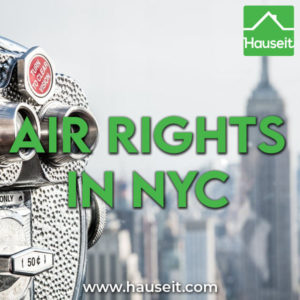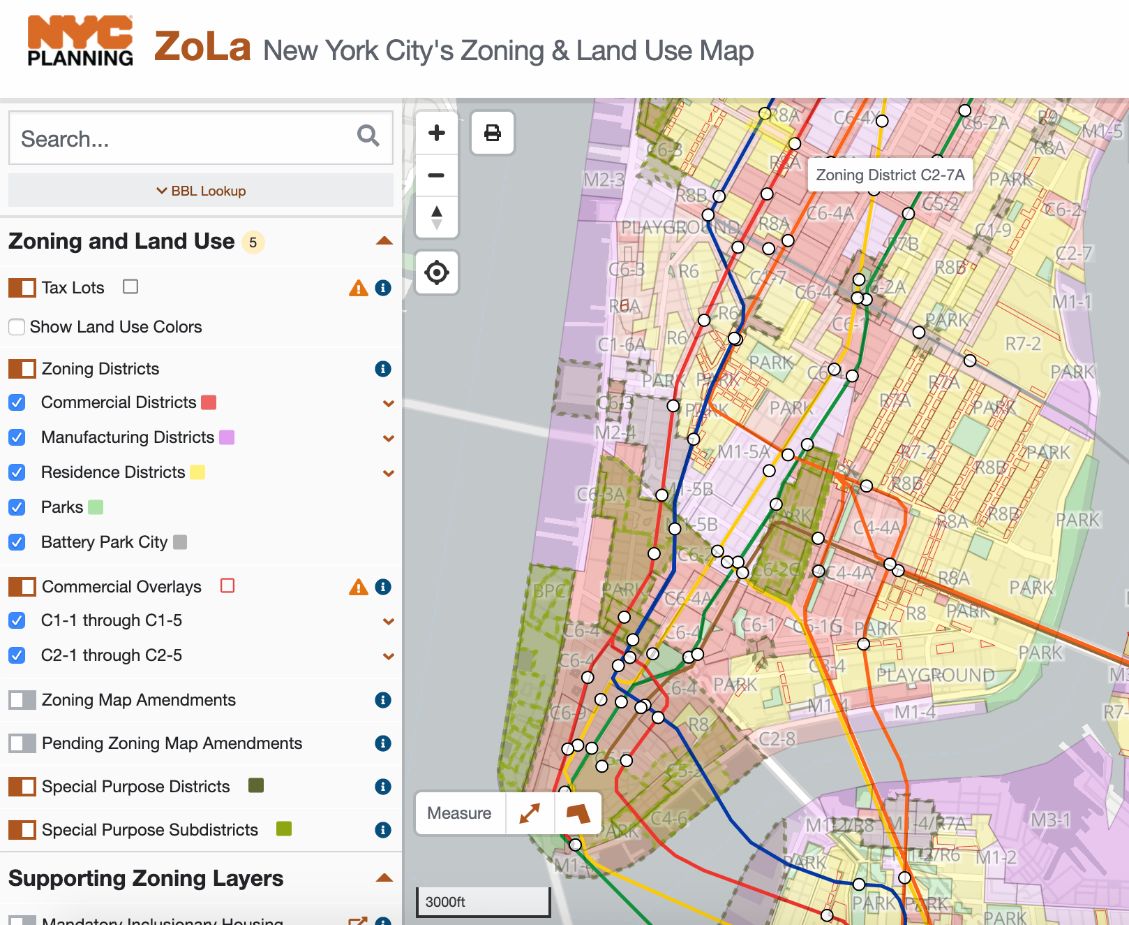Air rights in NYC refer to the empty space above or around a building which may be used for development. If a building is 50 feet tall but it could potentially be as high as 75 feet, the unused 25 feet are referred to as unused development rights or air rights.
The owner of this building could potentially add additional stories or sell her or his unused airspace to an adjacent building which would then be allowed to construct a taller building by combining the development rights from both lots.
Air rights is an important topic for developers, multi-use property owners, townhouse, condo and co-op buyers and sellers as well as real estate brokers. Air rights are also referred to as Unused Development Rights, Excess Developments, Transferred Development Rights and Available Development Rights.
For an existing building, the amount of unused development rights equals the maximum amount of floor area permitted in the zoning lot where the building is located minus the amount of floor area utilized by the existing structure(s).
The Zoning Resolution (ZR) of the City of New York determines the extent of permitted development rights for each zoning lot. More specifically, the Zoning Resolution regulates the size, height, setbacks, lot coverage and yards of buildings and other structures in NYC.
In recent years, New York City has created many contextual zoning districts across all five boroughs which impose height and other restrictions which may prevent full utilization of transferred development rights.
Air rights are determined by applying the Zoning Resolution to a zoning lot. A zoning lot is comprised of a single tax lot or two or more tax lots contiguous for at least 10 linear feet. The Zoning Resolution and amendments are adopted by the City Council and City Planning Commission in conjunction with other governmental agencies.
In 1961, NYC overhauled its zoning regulations in order to preserve air and light and prevent excessive development of tall structures in the city. Prior to 1961, the Zoning Resolution did not limit a building’s height, provided that the upper part of the structure (tower level) covered no more than 25% of the lot and complied with setback requirements.
The Floor-to-Area Ratio refers to the maximum square footage that can be built on a lot relative to the square footage of the lot. FAR is calculated by taking the total floor area of a zoning lot and dividing it by the lot area on the zoning lot.
For example, a building with 25,000 SqFt on a lot with a lot area of 5,000 SqFt has a FAR of 5 (25,000 SqFt / 5,000 SqFt).
Permitted FAR varies by zoning district and location as well as the use of the building (residential, commercial, manufacturing, etc.), among other factors.
A Full Service Listing for 1%
Sell your home with a traditional full service listing for just one percent commission.
The most common and easiest way to buy and sell air rights is to transact with an adjacent property that is contiguous for at least 10 linear feet.
There are two other more complicated ways to buy and sell air rights:
-
Special Zoning District Transfers
-
Landmark Transfers

The most common way to transfer air rights is through a zoning lot merger of contiguous tax lots. Through this method, the owner of the property with unused development rights sells her or his air rights to a neighboring lot which is contiguous for a minimum of 10 linear feet, located within the same block.
The effect of the zoning lot merger is that the unused development rights may be used in development or enlargement on any portion of the newly merged zoning lot. A zoning lot merger does not require special approval from the city.
It’s also possible to transfer development rights between non-contiguous properties on the same block by through-lot transfers, which merge lots for the purpose of allocating Available Development Rights from former non-contiguous zoning lots (Through-Lot Transfers).
Get a 2% Rebate When You Buy
Save thousands on your home purchase with a buyer agent commission rebate from Hauseit
Special Zoning District Transfers
The sale and transfer of development rights in Special Zoning Districts is permitted between lots which aren’t contiguous. Examples of special zoning district transfers include:
-
Transfer of development rights from listed theaters in the Theater Subdistrict of Special Midtown District, subject to CPC certification, authorization or special permit
-
Transfer of development rights from landmark sites in Grand Central Subdistrict of Special Midtown District, by special permit or certification
-
Special West Chelsea District (High Line Corridor), pursuant to as-of-right procedure at DOB with required notice to and review by Department of City Planning
-
South Street Subdistrict of Special Lower Manhattan District, subject to certification from City Planning Commission
-
Transfer of development rights from certain granting sites in Special Hudson Yards District
Landmark Transfers
Under a Landmark Transfer, a Landmarks Preservation Commission designated site may sell development rights to another property, and there is no requirement for both sites to be contiguous.
For example, a landmarked building may sell its development rights to a building across the street or down the block. Landmark transfers provide owners of landmarked buildings with a way to generate revenue to help pay for building upkeep and other projects.
A Transfer of Development Rights, also known as a TDR, from a Landmark site to adjacent lots or lots across the street requires a Special Permit from the City Planning Commission.
The special permit application is subject to the Uniform Land Use Review Procedure (ULURP) provisions of City Charter and environmental review pursuant to the State Environmental Quality Review Act (SEQRA). It also requires certain findings to be made by the City Planning Commission.
Get a 2% Rebate When You Buy
Save thousands on your home purchase with a buyer agent commission rebate from Hauseit
What Are Zoning Districts in NYC?
New York City is divided into three zoning districts: residential (R), manufacturing (M) and commercial (C). Each district is further subdivided into low, medium and high density residential, manufacturing and commercial districts.
Zoning districts can be further overlaid by ‘Special Purpose Zoning Districts’ such as the Special Little Italy District in Lower Manhattan.
Another type of zoning district overlay is a ‘Commercial Overlay.’ This is commonly seen in residential zoning districts and it provides for the accommodation of neighborhood retail stores within the zoning district.
Another type of zoning district overlay is a ‘Limited Height District.’ Such an overlay imposes height limits on new buildings in certain historic districts which are designated as such by the Landmarks Preservation Commission.
Zoning districts, commercial overlays and special purpose districts may be viewed by accessing New York City’s Zoning & Land Use Map which is shown below:

New York City’s Zoning Resolution (ZR) also includes a zoning text which establishes zoning districts and sets forth the rules governing their use and development.
If a newly created zoning lot is divided by zoning district boundaries, unused floor area may not be transferred across such district boundaries unless both districts have the same FAR regulations.
How Much Do Air Rights Cost in NYC?
Air rights in NYC range from $200 to $400 per square foot, but this is negotiable and pricing varies by location and project. Air rights in prime Manhattan neighborhoods with a scarcity of unused development rights can be $400 per square foot or more.
Air rights are sold and transferred through a Purchase and Sale Agreement, similar to what is used when selling a condo, co-op or house. The contract may also contain a light and air easement provision which, for example, may prevent the seller from blocking the views from the upper floors of the developer’s building.
Other documents required to effectuate a transfer of unused development rights include:
-
Declaration of Zoning Lot Restrictions
-
Zoning Lot and Development Agreement (ZLDA)
-
Title Company Certification
-
Zoning Lot Description and Ownership Statement by Building Department Applicant
-
Department of Buildings – Plan/Work Approval Application





